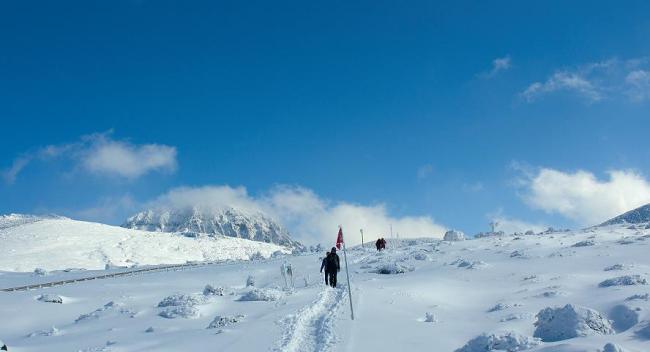Jeju as top winter destination
From snow-trekking to mandarin picking, the southern island offers deals for holidaymakers
By Korea HeraldPublished : Jan. 18, 2013 - 19:30

The bone-piercing cold has gripped the nation, with the mercury dropping well below minus 14 degrees Celsius.
But there is a place where you can seek shelter from one of the harshest winters in recent memory. The southern island of Jeju has always been one of Korean’s favorite holiday destinations and in winter, it may well become the optimal choice for those who cannot stand the bitter cold.
Travel with warmth
While Seoul and the central part of the Korean Peninsula have been suffering through unprecedented cold, Jeju has been enjoying abundant sunshine and warmth.
According to the Korea Meteorological Administration, the average temperature during daytime in Seogwipo in December marked 12.4 degrees Celsius and 9.6 degrees Celsius so far this month.
“There wasn’t a day the mercury went down to the sub-zero level between December 2010 and February 2011, and we are expecting a similar pattern this year, too,” the KMA said in its monthly report. And according to the Jeju Tourism Organization, more than 656,000 people, including 10,500 foreigners, visited the island in December.
Trekking Mt. Hallasan: Jeju is often called “the skirt of Mt. Hallasan” because the 1,950-meter-high mountain is visible from nearly everywhere on the island.
Climbing the dormant volcano is prohibited when a heavy snow alert is imposed but is open to hikers otherwise. There is only a slim chance of seeing the crater, Baekrokdam ― mountain climbers say that the crater is visible for less than 70 days a year since fog and other inclement weather conditions deter visibility ― yet, more than 6,000 people a day brave the cold weather and possibly slippery slopes to see the mountain.
“It takes about nine to 11 hours to climb and get back. It isn’t an easy course but the scenery changes every 200 meters and the landscape of snow is worth every toil,” said Baek Young-soo, a 41-year-old woman who managed to climb to the very top of the mountain in early January.
At the foot of the mountain, in Seongpanak and Gwaneumsa, visitors can be certified of their “victory” at the park management office by submitting a photo of the mountain peak and paying 1,000 won. For more information, call (064) 713-9950 or visit www.hallasan.go.kr.
Walk the trail: Since the launch of “Jeju Olle” in 2007, more than 870,000 people have visited a total of 25 trails along the island’s coastline. It first started with four courses benchmarking the internationally famous “Camino de Santiago” in Spain but now it has three sister trails in the U.K., Switzerland and Canada. It even has “Olle” in Kyushu of Japan named after the successful Korean model.
Famous for the “Three ‘manys’ ― rocks, water and wind,” the narrow trails weaving between traditional houses sometimes leading to mountains, hillsides or the seaside have become signature tourist attractions.
Thanks to the mild weather “walkers” do not need down jackets to stay warm. All you’ll need is a pair of good sunglasses to protect your eyes from the strong sun and a bottle of sunscreen to slather on every now and then.
Just follow the blue or orange ribbons and pickets along the 14-kilometer to 21-kilometer trails; sip coffee at cafes along the way and enjoy local delicacies. If you are a woman walking the road alone, don’t forget to register with the Jeju Olle Foundation at (064) 762-2190, as a safety precaution. For more information about Olle visit http://www.jejuolle.org.
Golf: Snow might have killed off the grass in the fields and let down golf-enthusiasts, but Jeju residents boast that the island is the only place in Korea where golf is available all year around. There are 33 golf courses on the southern island with a considerable number of them offering high-end accommodations and dining facilities.
“Weather in Jeju is quite volatile but there are still people visiting the course to enjoy golf,” a worker of a golf course in southern Jeju said.
Seasonal delicacies
Mandarin tangerine: Winter might not seem to be the best season for fruits in other parts of the country, but in Jeju it is the right time to taste noji gamgyul, or tangerine. Instead of those grown in greenhouses, these are grown in orchards using little or no pesticides.
“They are sweeter and healthier for the body,” said Kim Hyun-jung, a regular visitor to Jeju, said.
Hallabong, cheonhyehyang, baeklihyang and other sister-citrons of tangerines are also not-to-miss fruits.
Some orchards, always short of manpower, offer programs where people pay about 10,000 won to pick citrons and keep them. Hotels and guesthouses offer detailed information about such farms.
Sashimi and black pork: Local black pork is from black pigs raised in traditional ways. These pigs have chewier and juicier meat thanks to denser “marbling,” Jang Jae-ho of the Jeju Tourism Organization said.
Sashimi is also “hot” ― from mackerel to flounder, sea squirt and sea cucumbers, a wide selection of seafood is available at sashimi restaurants. Yellow tail fish is the most recommended at this time of the year.
Cozy lodging
While summer is the most cherished season for holidaymakers and backpackers seeking affordable accommodations with quality service, it is actually winter that best meets the needs.
Guesthouses with dormitories and private rooms offer discounts during the off season. People can socialize, share travel information and sometimes travel around the island together.
Guesthouse Laputa in Seogwipo city (http://blog.naver.com/hananets) offers each party an individual room at the rate of 34,000 ― 64,000 won. Breakfast and pick-up service are provided and the host holds get-together sessions every other day.
By Bae Ji-sook (baejisook@heraldcorp.com)
But there is a place where you can seek shelter from one of the harshest winters in recent memory. The southern island of Jeju has always been one of Korean’s favorite holiday destinations and in winter, it may well become the optimal choice for those who cannot stand the bitter cold.
Travel with warmth
While Seoul and the central part of the Korean Peninsula have been suffering through unprecedented cold, Jeju has been enjoying abundant sunshine and warmth.
According to the Korea Meteorological Administration, the average temperature during daytime in Seogwipo in December marked 12.4 degrees Celsius and 9.6 degrees Celsius so far this month.
“There wasn’t a day the mercury went down to the sub-zero level between December 2010 and February 2011, and we are expecting a similar pattern this year, too,” the KMA said in its monthly report. And according to the Jeju Tourism Organization, more than 656,000 people, including 10,500 foreigners, visited the island in December.
Trekking Mt. Hallasan: Jeju is often called “the skirt of Mt. Hallasan” because the 1,950-meter-high mountain is visible from nearly everywhere on the island.
Climbing the dormant volcano is prohibited when a heavy snow alert is imposed but is open to hikers otherwise. There is only a slim chance of seeing the crater, Baekrokdam ― mountain climbers say that the crater is visible for less than 70 days a year since fog and other inclement weather conditions deter visibility ― yet, more than 6,000 people a day brave the cold weather and possibly slippery slopes to see the mountain.
“It takes about nine to 11 hours to climb and get back. It isn’t an easy course but the scenery changes every 200 meters and the landscape of snow is worth every toil,” said Baek Young-soo, a 41-year-old woman who managed to climb to the very top of the mountain in early January.
At the foot of the mountain, in Seongpanak and Gwaneumsa, visitors can be certified of their “victory” at the park management office by submitting a photo of the mountain peak and paying 1,000 won. For more information, call (064) 713-9950 or visit www.hallasan.go.kr.
Walk the trail: Since the launch of “Jeju Olle” in 2007, more than 870,000 people have visited a total of 25 trails along the island’s coastline. It first started with four courses benchmarking the internationally famous “Camino de Santiago” in Spain but now it has three sister trails in the U.K., Switzerland and Canada. It even has “Olle” in Kyushu of Japan named after the successful Korean model.
Famous for the “Three ‘manys’ ― rocks, water and wind,” the narrow trails weaving between traditional houses sometimes leading to mountains, hillsides or the seaside have become signature tourist attractions.
Thanks to the mild weather “walkers” do not need down jackets to stay warm. All you’ll need is a pair of good sunglasses to protect your eyes from the strong sun and a bottle of sunscreen to slather on every now and then.
Just follow the blue or orange ribbons and pickets along the 14-kilometer to 21-kilometer trails; sip coffee at cafes along the way and enjoy local delicacies. If you are a woman walking the road alone, don’t forget to register with the Jeju Olle Foundation at (064) 762-2190, as a safety precaution. For more information about Olle visit http://www.jejuolle.org.
Golf: Snow might have killed off the grass in the fields and let down golf-enthusiasts, but Jeju residents boast that the island is the only place in Korea where golf is available all year around. There are 33 golf courses on the southern island with a considerable number of them offering high-end accommodations and dining facilities.
“Weather in Jeju is quite volatile but there are still people visiting the course to enjoy golf,” a worker of a golf course in southern Jeju said.
Seasonal delicacies
Mandarin tangerine: Winter might not seem to be the best season for fruits in other parts of the country, but in Jeju it is the right time to taste noji gamgyul, or tangerine. Instead of those grown in greenhouses, these are grown in orchards using little or no pesticides.
“They are sweeter and healthier for the body,” said Kim Hyun-jung, a regular visitor to Jeju, said.
Hallabong, cheonhyehyang, baeklihyang and other sister-citrons of tangerines are also not-to-miss fruits.
Some orchards, always short of manpower, offer programs where people pay about 10,000 won to pick citrons and keep them. Hotels and guesthouses offer detailed information about such farms.
Sashimi and black pork: Local black pork is from black pigs raised in traditional ways. These pigs have chewier and juicier meat thanks to denser “marbling,” Jang Jae-ho of the Jeju Tourism Organization said.
Sashimi is also “hot” ― from mackerel to flounder, sea squirt and sea cucumbers, a wide selection of seafood is available at sashimi restaurants. Yellow tail fish is the most recommended at this time of the year.
Cozy lodging
While summer is the most cherished season for holidaymakers and backpackers seeking affordable accommodations with quality service, it is actually winter that best meets the needs.
Guesthouses with dormitories and private rooms offer discounts during the off season. People can socialize, share travel information and sometimes travel around the island together.
Guesthouse Laputa in Seogwipo city (http://blog.naver.com/hananets) offers each party an individual room at the rate of 34,000 ― 64,000 won. Breakfast and pick-up service are provided and the host holds get-together sessions every other day.
By Bae Ji-sook (baejisook@heraldcorp.com)
-
Articles by Korea Herald








![[Hello India] Hyundai Motor vows to boost 'clean mobility' in India](http://res.heraldm.com/phpwas/restmb_idxmake.php?idx=644&simg=/content/image/2024/04/25/20240425050672_0.jpg&u=)










